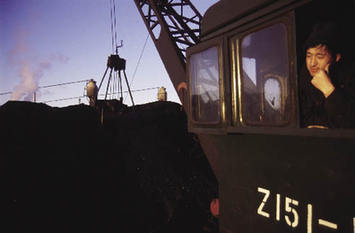|
Coal: the Main Culprit
 |
|
Coal is China's main energy source. |
The Intergovernmental Panel on Climate Change (IPCC) concluded back in the late 1980s that the last half century of rapid climate change has been caused by human activities, primarily industrialization. According to Lin Erda, these changes are the result of overusing petroleum and coal for 200 years, releasing a huge amount of carbon dioxide into the atmosphere, where it can remain for over a century. "We still have the carbon dioxide emitted by people who lived over 100 years ago," explains Lin. "The gas is like a heavy blanket over the earth, making our globe increasingly warmer."
In China, the main pollution source is coal.
The True Cost of Coal, produced by Chinese energy research institutes under the auspices of Greenpeace, points out that coal makes up 70 percent of China's energy consumption. Annual coal production and sales both exceed 2.5 billion tons, making China the biggest coal miner and consumer in the world. Coal burning is the chief culprit of climate change and acid rain in China, producing 70 percent of the country's smoke and dust, 85 percent of its sulphur dioxide, and 67 percent of its nitrogen oxide.
Chinese people have heard of, and in some cases understand, the meaning of "climate change" and "global warming." But public awareness of the urgency and seriousness of the situation is far from adequate. Most people are confused about the sources of greenhouse gases and the question of how to reduce them.
Greenpeace is an international organization that works to protect the environment. Its climate change project has been going on in China for four years. "By making the public aware of the urgency and seriousness of global warming," says Li Yan, "we hope the entire society will wake up to the problem. In addition, we hope to prompt policy makers to take more active measures to improve energy structures."
The publication of The True Cost of Coal is not the end of Greenpeace's efforts. The organization plans to make frequent visits to places seriously affected by coal consumption. Their objective is to encourage a reform in coal pricing. "As a non-government organization (NGO)," explains Li Yan, "all Greenpeace can do is conduct research programs or hold discussions, and pass suggestions onto related governmental departments." In 2006, Greenpeace was the only NGO invited by the Chinese government to contribute suggestions before the Renewable Energy Law became effective.
Li Yan and Liu Shuang, two representatives from Greenpeace China, made their non-governmental voice heard at the UN Climate Change Conference held in Poznan, Poland in December 2008.
"China's economic growth mode is facing a huge challenge," states Li Yan. "The past mode featuring high pollution and high energy consumption has seriously harmed the Chinese economy, as well as society, the environment and people's health. Development has been accompanied by huge waste of precious energy resources, most of which are not renewable."
Fortunately, both the Chinese government and the public have come to realize this. In the Eleventh Five-year Plan (2007-2012), the government set an objective of reducing the energy consumed per unit of GDP by 20 percent, and pollutant emissions by 10 percent. Li Yan says this objective shows the government's serious concern and determination.
| 